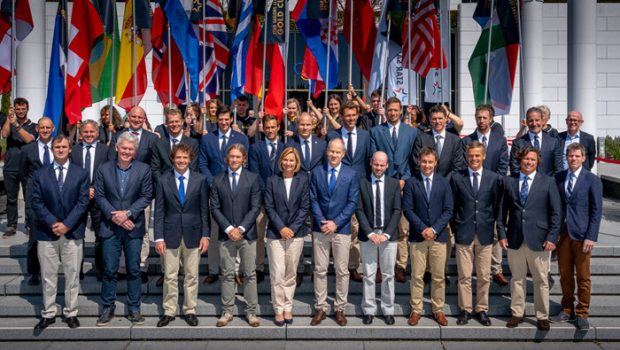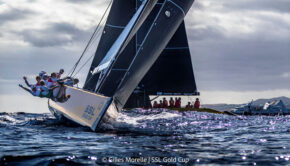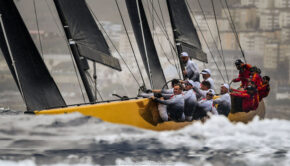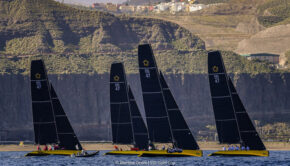Details revealed for SSL Gold Cup
Published on April 15th, 2019
Lausanne, Switzerland (April 15, 2019) – Initially announced in October 2018, planning for the Star Sailors League (SSL) Gold Cup has further evolved as the format and competing countries are revealed.
The SSL Gold Cup concept is for each nation’s top sailing athletes to team together into a single crew and then race against one another aboard high performance 47 foot long one design monohulls to establish ‘the world’s best sailing nation’.
The event was born from the Star Sailors League (SSL), founded in 2013 as an international Star Class regatta circuit with the goal to promote the athletes and sailing in a simple format. Privately funded by a group of passionate sailors, with substantial prize money at Star events, the SSL has proven popular for its participants.
Boats for the SSL Gold Cup will be supplied with the event to occur biennially, taking place for the first time in Switzerland during September and October 2021.
Polish double Olympic Finn medalist Mateusz Kusznierewicz, who has been appointed Sports Director of the SSL Gold Cup, explains how the event concept will be very similar to the football World Cup. “The SSL Gold Cup will start with qualification stages and then progresses to quarter-finals, semi-finals and on to finals. That works well in other sports and we want to do the same in sailing.”
This format has already been trialed and developed over the last five years with the Star Class at the SSL events.
Specifically, the SSL Gold Cup format will comprise four knock-out qualifying rounds for 16 teams each, taking place out of SSL’s headquarters and training center on Lake Neuchâtel in Grandson, Switzerland. Each of these 16 will be divided into four flights of four boats, the outcome of each based on up to five windward-leeward races.
“We sat down together with the likes of Craig Monk, Paul Cayard, and Sime Fantela, and many more leading sailors, and discussed about how many boats would make it easiest for the spectators to understand the racing,” says Kusznierewicz. “We concluded that four boats was the easiest, also to keep the racing tight and give a chance to teams who are less experienced – without it being a match race.”
Teams will join the competition according to their pre-event seeding. This seeding will be based on a formula for how each nation ranks over a series of events spanning the breadth of international sailing, both yachts and dinghies, with the final calculations including both the Tokyo 2020 Olympic Games and the 36th America’s Cup in New Zealand in April 2021.
The lowest seeded nations will start in the earliest qualifications for the SSL Gold Cup while more successful nations will join the competition subsequently. “It is similar in tennis where, for example, Roger Federer doesn’t play in the qualifiers, due to his previous success,” notes Kusznierewicz.
After the qualification rounds, the SSL Gold Cup then moves for the final rounds from Lake Neuchâtel to Lake Geneva in Switzerland. The top eight nations from the qualifying rounds join the top eight seeded teams in the quarter-finals. The top eight from this stage progress through semi-finals to determine the four finalists and ultimately the winner being crowned the SSL Gold Cup champion nation.
“The idea is to make it as simple as possible – so the quarter-finals and semi-finals will consist of five races, while the finals will be single race,” continues Kusznierewicz. “We want to make it really easy for spectators to understand who is the winner and which team will be crowned the ‘best sailing nation’.”
The SSL Gold Cup is open to any nations of the 144 Member National Authorities recognized by World Sailing. As the chances for developed sailing nations will be significantly better than for emerging nations, the format has been designed to boost the chances for emerging nations.
To achieve this, the SSL divides the world into three zones: Europe, Africa-Americas, Oceania-Asia. This is then reflected in the number of entries from each – so at each stage of the qualifying rounds the fresh influx of entries will comprise 50% from Europe and 25% each from Africa-Americas and Oceania-Asia.
Within the first three months after the entry period opened, and with six months to go until the entry deadline for the 2021 SSL Gold Cup, forty countries from all five continents confirmed their participation. A maximum of 48 teams will be able compete in this first edition of the SSL Gold Cup.
Sailing teams will be comprised of eleven crew which must be passport-carrying nationals in line with the nationality requirements of the Olympic Games.
For each team a ‘captain’ is selected. The captain is likely to sail on board, but that is not required. Among the captain’s responsibilities are to manage and co-ordinate the team, to act as ambassador for the team and to run the finances of the campaign.
The first group of nations has been revealed today:
BRAZIL – represented by Robert Scheidt
CANADA – represented by Richard Clarke (C)
CROATIA – represented by Igor Marenič on behalf of Sime Fantela (C)
ESTONIA – represented by Tõnu Tõniste (C), Tommas Tõniste and Andrus Poksi
GERMANY – represented by Frithjof Kleen (C), Jochen Schümann, Philipp Buhl
GREAT BRITAIN – represented by Matthew Cornwell on behalf of Ian Williams (C)
GREECE – represented by Sofia Bekatorou (C), Michail Pateniotis
HUNGARY – represented by Zsombor Berecz (C)
ITALY – represented by Vasco Vascotto (C) and Francesco Bruni
THE NETHERLANDS – represented by Roy Heiner (C)
NORWAY – represented by Eivind Melleby (C)
POLAND – represented by Mateusz Kusznierewicz (C)
PORTUGAL – represented by João Rodrigues (C) and Afonso Dominguez
SLOVENIA – represented by Vasilij Žbogar (C)
SPAIN – represented by Roberto Bermudez on behalf of Luis Doreste (C)
SWEDEN – represented by Freddy Lööf (C)
SWITZERLAND – represented by Eric Monnin (C)
TURKEY – represented by Aliçan Keynar (C)
UNITED STATES OF AMERICA – represented by Paul Cayard (C)
Some of the teams are already forming, such as the Italian team with Vasco Vascotto as captain and leading America’s Cup sailor Francesco Bruni as helmsman. Similarly, Star sailor Frithjof Kleen is captain of the German team which includes Olympic legend and America’s Cup winner Jochen Schümann.
Other sailors on board will be the four highest placed for that nation in the SSL Ranking. The SSL Ranking system has been developed over the past five years from the results in the Star Class, with the system now set to be applied to other classes over the coming months.
“Every week from now, you will see the new classes and new results being included,” explains Kusznierewicz. “By the end of this year everyone from Optimists to Lasers to J/70s, to the Olympic classes, and all inshore racers will be included. That’s really exciting because it is the first time that sailors in one class will be able to compare themselves directly with those in another.”
The SSL47 high performance keelboat will be based at the new headquarters on the shore of Lake Neuchâtel in Switzerland. The facilities include a private harbor, broadcast center and TV studio, and a fitness center, all housed within the grounds of a manor house set in a large private park.
SSL Gold Cup teams will get the opportunity train from April 2019 until August 2021, with the allocation of time to vary according to the caliber of the teams. The most experienced teams will have the opportunity of training for 10 days per year; World Sailing ‘Emerging Nations’ getting 30 days.
Details: https://goldcup.starsailors.com/
Source: Rachele Vitello









 We’ll keep your information safe.
We’ll keep your information safe.